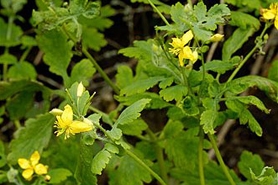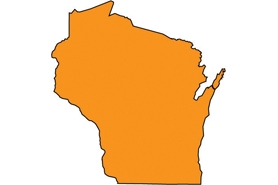Celandine
(Chelidonium majus)
Herbaceous biennial, sometimes perennial, that grows up to 2’ tall. Greater celandine has sprawling branches and ribbed stems covered with soft hairs.
When broken, it reveals an orange-yellow sap. *Sap is irritating to the skin and eyes, and highly toxic if ingested.
Other names for this plant include:
- Common names: greater celandine
- Scientific names: C. majus var laciniatum; C. majus var majus; C. majus var plenum
Classification in Wisconsin: Restricted
Ecological Threat
- Often found in roadsides, gardens, forest edges and woodlands. Celandine prefers disturbed areas with moist soil.
- The sap is irritating to skin and eyes, making the plant unpalatable to most foragers. It is highly toxic to humans if ingested; however, it is commonly used in medicines.
- It can outcompete native plants in minimally managed land and is very difficult to remove once established.
Identification
Leaves: Alternate leaves are deeply lobed, with rounded teeth and compound. Leaves are up to 6” long and 3” wide with 5 leaflets or lobes that are ovate. Leaves are slightly hairy, green above and pale green below, with have fine hairs along the leaf veins. When stems are broken, toxic orange-yellow sap exudes.
Flowers: Yellow flowers have 4 petals in axillary umbels of 3-8 flowers. Flowers bloom from April-September.
Fruits & seeds: Cylindrical, ¾-2” long and tapering seed pods toward the apex. Fruits are hairless and as it ripens, the pod constricts at intervals. Seeds are shiny black, oval, flat and readily dispersed by ants. Seeds also have pitting on the surface.
Roots: Taproot with a semi-woody stem base.
Similar species: Celandine poppy (Stylophorum diphyllum; native) and horned poppy (Glaucium flavum; non-native) have similar yellow-orange sap and yellow, 4-petaled flowers. Celandine poppy is hairless and the flower petals are larger (3/4-1” long). Horned poppy is hairy like greater celandine but its flowers are larger (2-3.5”) and more poppy-like. Narrowleaf bittercress (Cardamine impatiens; invasive) rosettes are similar to greater celandine but are hairless.
Control
Mechanical: Hand pull or dig up before seed set. Dispose of in a landfill or burn.
Chemical: Foliar spray with glyphosate.
Resources
Sources for content:
- Gleason, H., Cronquist, A. 1991. Manual of Vascular Plant of Northeastern United States and Adjacent Canada Second Edition; pg 66.
- Hilty, John. Illinois Wildflowers. Weedy Wildflowers of Illinois – Greater Celandine [exit DNR] (Chelidonium majus).
- Invasive Plant Atlas of New England – Celandine [exit DNR] (Chelidonium majus).
- Chelidonium majus. Klinkenberg, Brian. (Editor) 2009. E-Flora BC: Electronic Atlas of the Plants of British Columbia [eflora.bc.ca]. Lab for Advanced Spatial Analysis, Department of Geography, University of British Columbia, Vancouver.
Links for more information:



